A Simple Method to Identify Potential Groundwater-Dependent Vegetation Using NDVI MODIS
Abstract
1. Introduction
2. Material and Methods
2.1. Study Area, Aridity Index, and Land Cover
2.2. Normalized Differences Vegetation Index
2.3. Water Table Depth
2.4. Identification of Potential Groundwater-Dependent Vegetation
2.5. Validation and Statistical Analysis
3. Results
3.1. Identification of Potential GDV
3.2. Validation with Water Table Depth
3.3. Land Cover Analysis
3.4. Comparison with in Situ GDV Identification
4. Discussion
5. Conclusions
Author Contributions
Funding
Acknowledgments
Conflicts of Interest
References
- Nemani, R.R.; Keeling, C.D.; Hashimoto, H.; Jolly, W.M.; Piper, S.C.; Tucker, C.J.; Myneni, R.B.; Running, S.W. Climate-driven increases in global terrestrial Net Primary Production from 1982 to 1999. Science 2003, 300, 1560–1563. [Google Scholar] [CrossRef] [PubMed]
- Pereira, L.S.; Oweis, T.; Zairi, A. Irrigation management under water scarcity. Agric. Water Manag. 2002, 57, 175–206. [Google Scholar] [CrossRef]
- Eamus, D.; Froend, R.; Loomes, G.; Hose, G.; Murray, B. A functional methodology for determining the groundwater regime needed to maintain the health of groundwater-dependent vegetation. Aust. J. Bot. 2006, 54, 97–114. [Google Scholar] [CrossRef]
- Haase, P.; Pugnaire, F.I.; Fernandéz, E.M.; Puigdefábregas, J.; Clark, S.C.; Incoll, L.D. An investigation of rooting depth of the semiarid shrub Retama sphaerocarpa (L.) Boiss. by labelling of ground water with a chemical tracer. J. Hydrol. 1996, 177, 23–31. [Google Scholar] [CrossRef]
- Filella, I.; Peñuelas, J. Indications of hydraulic lift by Pinus halepensis and its effects on the water relations of neighbour shrubs. Biol. Plant. 2003, 47, 209–214. [Google Scholar] [CrossRef]
- David, T.S.; Ferreira, M.I.; Cohen, S.; Pereira, J.S.; David, J.S. Constraints on transpiration from an evergreen oak tree in southern Portugal. Agric. For. Meteorol. 2004, 122, 193–205. [Google Scholar] [CrossRef]
- Lubczynski, M.W.; Gurwin, J. Integration of various dta sources for transient grondwater modeling with spatio-temporally variable fluxes—Sardon study case, Spain. J. Hydrol. 2005, 306, 71–96. [Google Scholar] [CrossRef]
- Kurz-Besson, C.; Otieno, D.; Lobo do Vale, R.; Siegwolf, R.; Schmidt, M.; Herd, A.; Nogueira, C.; David, T.S.; David, J.S.; Tenhunen, J. Hydraulic lift in cork oak trees in a savannah-type Mediterranean ecosystem and its contribution to the local water balance. Plant Soil 2006, 282, 361–378. [Google Scholar] [CrossRef]
- David, T.S.; Pinto, C.A.; Nadezhdina, N.; Kurz-Besson, C.; Henriques, M.O.; Quilhó, T.; Cermak, J.; Chaves, M.M.; Pereira, J.S.; David, J.S. Root functioning, tree water use and hydraulic redistribution in Quercus suber trees: A modeling approach based on root sap flow. For. Ecol. Manag. 2013, 307, 136–146. [Google Scholar] [CrossRef]
- Pinto, C.C.; Nadezhdina, N.; David, J.S.; Kurz-Besson, C.; Caldeira, M.C.; Henriques, M.O.; Monteiro, F.G.; Pereira, J.S.; David, T.S. Transpiration in Quercus suber trees under shallow water table conditions: The role of soil and groundwater. Hydrol. Process. 2014, 28, 6067–6079. [Google Scholar] [CrossRef]
- Nadezhdina, N.; Ferreira, M.I.; Conceição, N.; Pacheco, C.A.; Häusler, M.; David, T.S. Water uptake and hydraulic redistribution under a seasonal climate: Long-Term study in a rainfed olive orchard. Ecohydrology 2015, 8, 387–397. [Google Scholar] [CrossRef]
- Mendes, M.P.; Ribeiro, L.; David, T.S.; Costa, A. How dependent are cork oak (Quercus suber L.) woodlands on groundwater? A case study in southwestern Portugal. For. Ecol. Manag. 2016, 378, 122–130. [Google Scholar] [CrossRef]
- Costa, A.; Barbosa, I.; Roussado, C.; Graça, J.; Spiecker, H. Climate response of cork growth in the Mediterranean oak (Quercus suber L.) woodlands of southwestern Portugal. Dendrochronologia 2016, 38, 72–81. [Google Scholar] [CrossRef]
- Antunes, C.; Barradas, M.C.D.; Zunzunegui, M.; Vieira, S.; Pereira, S.; Pereira, A.; Anjos, A.; Correia, O.; Pereira, M.J.; Máguas, C. Contrasting plant water-use responses to groundwater depth in coastal dune ecosystems. Funct. Ecol. 2018, 32, 1931–1943. [Google Scholar] [CrossRef]
- Gouveia, C.M.; Páscoa, P.; Russo, A.; Trigo, R.M. Land degradation trend assessment over Iberia during 1982–2012. Cuad. Investig. Geogr. 2016, 42, 89–112. [Google Scholar] [CrossRef]
- Esteban-Parra, M.S.; Rodrigo, F.S.; Castro-Díez, Y. Spatial and temporal patterns of precipitation in Spain for the period 1880–1992. Int. J. Clim. 1998, 18, 1557–1574. [Google Scholar] [CrossRef]
- Trigo, R.M.; DaCamara, C.C. Circulation weather types and their impact on the precipitation regime in Portugal. Int. J. Clim. 2000, 20, 1559–1581. [Google Scholar] [CrossRef]
- Andrade, C.; Corte-Real, J. Aridity conditions in the Iberian Peninsula during the XX century. Int. J. Environ. Sci. 2016, 1, 52–58. [Google Scholar]
- Vicente-Serrano, S.M.; Lopez-Moreno, J.I.; Beguería, S.; Lorenzo-Lacruz, J.; Sanchez-Lorenzo, A.; García-Ruíz, J.M.; Azorin-Molina, C.; Morán-Tejeda, E.; Revuelto, J.; Trigo, R. Evidence of increasing drought severity caused by temperature rise in southern Europe. Environ. Res Lett. 2014, 9, 044001. [Google Scholar] [CrossRef]
- Páscoa, P.; Gouveia, C.M.; Russo, A.; Trigo, R.M. Drought trends in the Iberian Peninsula over the last 112 years. Adv. Meteorol. 2017, 4653126. [Google Scholar] [CrossRef]
- Garcia-Herrera, R.; Paredes, D.; Trigo, R.M.; Trigo, I.F.; Hernández, H.; Barriopedro, D.; Mendes, M.A. The outstanding 2004–2005 drought in the Iberian Peninsula: Associated atmospheric circulation. J. Hidrometeorol. 2007, 8, 483–498. [Google Scholar] [CrossRef]
- Gouveia, C.M.; Trigo, R.M.; Beguería, S.; Vicente-Serrano, S.M. Drought impacts on vegetation activity in the Mediterranean region: An assessment using remote sensing data and multi-scale drought indicators. Glob. Planet Chang. 2017, 151, 15–27. [Google Scholar] [CrossRef]
- Gouveia, C.; Trigo, R.M.; DaCamara, C.C.; Libonati, R.; Pereira, J.M.C. The North Atlantic oscillation and European vegetation dynamics. Int. J. Clim. 2008, 28, 1835–1847. [Google Scholar] [CrossRef]
- Gouveia, C.; Trigo, R.M.; DaCamara, C.C. Drought and vegetation stress monitoring in Portugal using satellite data. Nat. Hazard Earth Syst. 2009, 9, 185–195. [Google Scholar] [CrossRef]
- Peña-Gallardo, M.; Vicente-Serrano, S.M.; Domínguez-Castro, F.; Beguería, S. The impact of drought on the productivity of two rainfed crops in Spain. Nat. Hazard Earth Syst. 2019, 19, 1215–1234. [Google Scholar] [CrossRef]
- Ribeiro, A.F.S.; Russo, A.; Gouveia, C.M.; Páscoa, P. Copula-Based agricultural drought risk of rainfed cropping systems. Agric. Water Manag. 2019, 223, 105689. [Google Scholar] [CrossRef]
- Leite, C.; Oliveira, V.; Lauw, A.; Pereira, H. Cork rings suggest how to manage Quercus suber to mitigate the effects of climate changes. Agric. For. Meteorol. 2019, 266–267, 12–19. [Google Scholar] [CrossRef]
- Peña-Gallardo, M.; Vicente-Serrano, S.M.; Camarero, J.J.; Gazol, A.; Sanchéz-Salguero, R.; Domínguez-Castro, F.; Kenawy, A.E.; Beguería-Portugés, S.; Gutiérrez, E.; de Luís, M. Drought sensitiveness on forest growth in peninsular Spain and the Balearic Islands. Forests 2018, 9, 524. [Google Scholar] [CrossRef]
- Marques, I.G.; Nascimento, J.; Cardoso, R.M.; Miguéns, F.; de Melo, M.T.C.; Soares, P.M.M.; Gouveia, C.M.; Besson, C.K. Mapping the suitability of groundwater dependent vegetation in a semi-arid Mediterranean area. Hydrol. Earth Syst. Sci. 2019, 23, 3525–3552. [Google Scholar] [CrossRef]
- Eamus, D.; Zolfaghar, S.; Villalobos-Veja, R.; Cleverly, J.; Huete, A. Groundwater-dependent ecosystems: Recent insights from satellite and field-based studies. Hydrol. Earth Syst. Sci. 2015, 19, 4229–4256. [Google Scholar] [CrossRef]
- White, W.N. A Method of Estimating Ground-Water Supplies Based on Discharge by Plants and Evaporation from Soil: Results of Investigations in Escalante Valley, Utah; Interior, US Geological Survey; United States Government Publishing Office: Washington, DC, USA, 1932.
- Miller, G.R.; Chen, X.; Rubin, Y.; Ma, S.; Baldocchi, D.D. Groundwater uptake by woody vegetation in a semiarid oak savanna. Water Resour. Res. 2010, 46, W10503. [Google Scholar] [CrossRef]
- Ehleringer, J.R.; Dawson, T.E. Water uptake by plants: Perspectives from stable isotope composition. Plant Cell Environ. 1992, 15, 1073–1082. [Google Scholar] [CrossRef]
- Zencich, S.J.; Froend, R.H.; Turner, J.V.; Gailitis, V. Influence of groundwater depth on the seasonal sources of water accessed by Banksia tree species on a shallow, sandy coastal aquifer. Oecologia 2002, 131, 8–19. [Google Scholar] [CrossRef] [PubMed]
- Kray, J.; Cooper, D.; Sanderson, J. Groundwater use by native plants in response to changes in precipitation in an intermountain basin. J. Arid. Environ. 2012, 83, 25–34. [Google Scholar] [CrossRef]
- Contreras, S.; Jobbágy, E.G.; Villagra, P.E.; Nosetto, M.D.; Puigdefábregas, J. Remote sensing estimates of supplementary water consumption by aridecosystems of central Argentina. J. Hydrol. 2011, 397, 10–22. [Google Scholar] [CrossRef]
- Eamus, D.; Fu, B.; Sprnger, A.E.; Stevens, L.E. Groundwater dependent ecosystems: Classification, identification techniques and threats. In Integrated Groundwater Management; Jakeman, A.J., Barreteau, O., Hunt, R.J., Rinaudo, J.D., Ross, A., Eds.; Springer: Cham, Switzerland, 2016; pp. 313–346. [Google Scholar] [CrossRef]
- Pérez Hoyos, I.C.; Krakauer, N.Y.; Khanbilvardi, R.; Armstrong, R.A. A review of advances in the identification and characterization of groundwater dependent ecosystems using geospatial technologies. Geosciences 2016, 6, 17. [Google Scholar] [CrossRef]
- Doody, T.M.; Barron, O.V.; Dowsley, K.; Emelyanova, I.; Fawcett, J.; Overton, I.C.; Pritchard, J.L.; van Dijk, A.I.J.M.; Warren, G. Continental mapping of groundwater dependent ecosystems: A methodological framework to integrate diverse data and expert opinion. J. Hydrol. Reg. Stud. 2017, 10, 61–81. [Google Scholar] [CrossRef]
- Barron, O.V.; Emelyanova, I.; Van Niel, V.G.; Pollock, D.; Hodgson, G. Mapping groundwater-dependent ecosystems using remote sensing measurements of vegetation and moisture dynamics. Hydrol. Process. 2014, 28, 372–385. [Google Scholar] [CrossRef]
- Gou, S.; Gonzales, S.; Miller, G.R. Mapping potential groundwater-dependent ecosystems for sustainable management. Groundwater 2015, 53, 99–110. [Google Scholar] [CrossRef]
- Anyamba, A.; Tucker, C.J. Analysis of Sahelian vegetation dynamics using NOAA-AVHRR NDVI data from 1981–2003. J. Arid. Environ. 2005, 63, 596–614. [Google Scholar] [CrossRef]
- Gouveia, C.M.; Bastos, A.; Trigo, R.M.; DaCamara, C.C. Drought impacts on vegetation in the pre-and post-fire events over Iberian Peninsula. Nat. Hazard Earth Sys. 2012, 12, 3123–3137. [Google Scholar] [CrossRef]
- Trigo, R.M.; Añel, J.; Barriopedro, D.; García-Herrera, R.; Gimeno, L.; Nieto, R.; Castillo, R.; Allen, M.R.; Massey, N. The record Winter drought of 2011–2012 in the Iberian Peninsula, in explaining extreme events of 2012 from a climate perspective. Bull. Am. Meteorol. Soc. 2013, 94, S41–S45. [Google Scholar]
- Barriopedro, D.; Gouveia, C.M.; Trigo, R.M.; Wang, L. The 2009/10 drought in China: Possible causes and impacts on vegetation. J. Hydrometeorol. 2012, 13, 1251–1267. [Google Scholar] [CrossRef]
- Alcaraz-Segura, D.; Cabello, J.; Paruelo, J. Baseline characterization of major Iberian vegetation types based on the NDVI dynamics. Plant Ecol. 2009, 202, 13–29. [Google Scholar] [CrossRef]
- Costa, R.; Fraga, H.; Fernandes, P.M.; Santos, J.M. Climate-Driven variability in vegetation greenness over Portugal. Clim. Res. 2018, 76, 95–113. [Google Scholar] [CrossRef]
- Soares, P.M.M.; Cardoso, R.M.; Lima, D.C.A.; Miranda, P.M.A. Future precipitation in Portugal: High-resolution projections using WRF model and EURO-CORDEX multi-model ensembles. Clim. Dynam. 2017, 49, 2503–2530. [Google Scholar] [CrossRef]
- Spinoni, J.; Vogt, J.; Naumann, G.; Carrao, H.; Barbosa, P. Towards identifying areas at climatological risk of desertification using the Koppen-Geiger classification and FAO aridity index. Int. J. Clim. 2015, 35, 2210–2222. [Google Scholar] [CrossRef]
- European Environment Agency (EEA). CLC2006 Technical Guidelines; EEA Technical Report No 17/2007; European Environmental Agency: Copenhagen, Denmark, 2007. [Google Scholar] [CrossRef]
- Fan, Y.; Li, H.; Miguez-Macho, G. Global patterns of groundwater depth. Science 2013, 339, 940–943. [Google Scholar] [CrossRef]
- Belo-Pereira, M.; Dutra, E.; Viterbo, P. Evaluation of global precipitation datasets over the Iberian Peninsula. J. Geophys. Res. 2011, 116, D20101. [Google Scholar] [CrossRef]
- Pasho, E.; Camarero, J.J.; de Luís, M.; Vicente-Serrano, S.M. Impacts of drought at different time scales on forest growth across a wide climatic gradient in north-eastern Spain. Agric. Meterol. 2001, 151, 1800–1811. [Google Scholar] [CrossRef]
- Tejedor, E.; de Luís, M.; Cuadrat, J.M.; Esper, J.; Saz, M.A. Tree-ring-based drought reconstruction in the Iberian Range (east of Spain) since 1694. Int. J. Biometeorol. 2015, 60. [Google Scholar] [CrossRef] [PubMed]
- Páscoa, P.; Gouveia, C.M.; Russo, A.; Trigo, R.M. The role of drought on wheat yield interannual variability in the Iberian Peninsula from 1929 to 2012. Int. J. Biometeorol. 2017, 61, 439–451. [Google Scholar] [CrossRef] [PubMed]
- Aires, L.M.; Pio, C.A.; Pereira, J.S. The effect of drought on energy and water vapour exchange above a mediterranean C3/C4 grassland in Southern Portugal. Agric. For. Meteorol. 2008, 148, 565–579. [Google Scholar] [CrossRef]
- Bastos, A.; Gouveia, A.C.; DaCamara, C.C.; Trigo, R.M. Modelling post-fire vegetation recovery in Portugal. Biogeosciences 2011, 8, 3593–3607. [Google Scholar] [CrossRef]
- Agencia Estatal de Meteorología (AEMET); Instituto de Meteorologia (IM). Iberian Climate Atlas. Air Temperature and Precipitation (1971–2000); Agencia Estatal de Meteorología: Madrid, Spain; Ministerio de Medio Ambiente y Medio Rural y Marino: Madrid, Spain; Instituto de Meteorologia de Portugal: Lisbon, Portugal, 2011; ISBN 978-84-7837-079-5. [Google Scholar]
- Karnieli, A.; Agam, N.; Pinker, R.T.; Anderson, M.; Imhoff, M.L.; Gutman, G.G.; Panov, N.; Goldberg, A. Use of NDVI and land surface temperature for drought assessment: Merits and limitations. J. Clim. 2010, 23, 618–633. [Google Scholar] [CrossRef]
- Kosztra, B.; Büttner, G.; Hazeu, G.; Arnold, S. Updated CLC Illustrated Nomenclature Guidelines; Final Report; European Environment Agency: Copenhagen, Denmark, 2019; Available online: https://land.copernicus.eu/user-corner/technical-library/corine-land-cover-nomenclature-guidelines/docs/pdf/CLC2018_Nomenclature_illustrated_guide_20190510.pdf (accessed on 27 January 2020).
- Canadell, J.; Jackson, R.B.; Ehleringer, J.R.; Mooney, H.A.; Sala, O.E.; Schulze, E.D. Maximum rooting depth of vegetation types at the global scale. Oecologia 1996, 108, 583–595. [Google Scholar] [CrossRef] [PubMed]
- Fan, Y.; Miguez-Macho, G.; Jobbágy, E.G.; Jackson, R.B.; Otero-Casal, C. Hydrologic regulation of plant rooting depth. Proc. Natl. Acad. Sci. USA 2017, 114, 10572–10577. [Google Scholar] [CrossRef]
- Guisan, A.; Zimmermann, N.E. Predictive habitat distribution models in ecology. Ecol. Model. 2000, 135, 147–186. [Google Scholar] [CrossRef]
- Ministerio de Agricultura, Pesca y Alimentación (MAPA). Encuesta Sobre Superficies y Rendimientos de Cultivos; Resultados 2005. 2006. Available online: https://www.mapa.gob.es/es/estadistica/temas/estadisticas-agrarias/boletin2005_tcm30-122325.pdf (accessed on 29 November 2019).
- Stigter, T.Y.; Carvalho Dill, A.M.M.; Ribeiro, L.; Reis, E. Impact of the shift from groundwater to surface waterirrigation on aquifer dynamics and hydrochemistry in a semi-arid region in the south of Portugal. Agric. Water Manag. 2006, 85, 121–132. [Google Scholar] [CrossRef]
- Liu, Y.; Li, Y.; Li, S.; Motesharrei, S. Spatial and temporal patterns of global NDVI trends; correlations with climate and human factors. Remote Sens. 2015, 7, 13233–13250. [Google Scholar] [CrossRef]

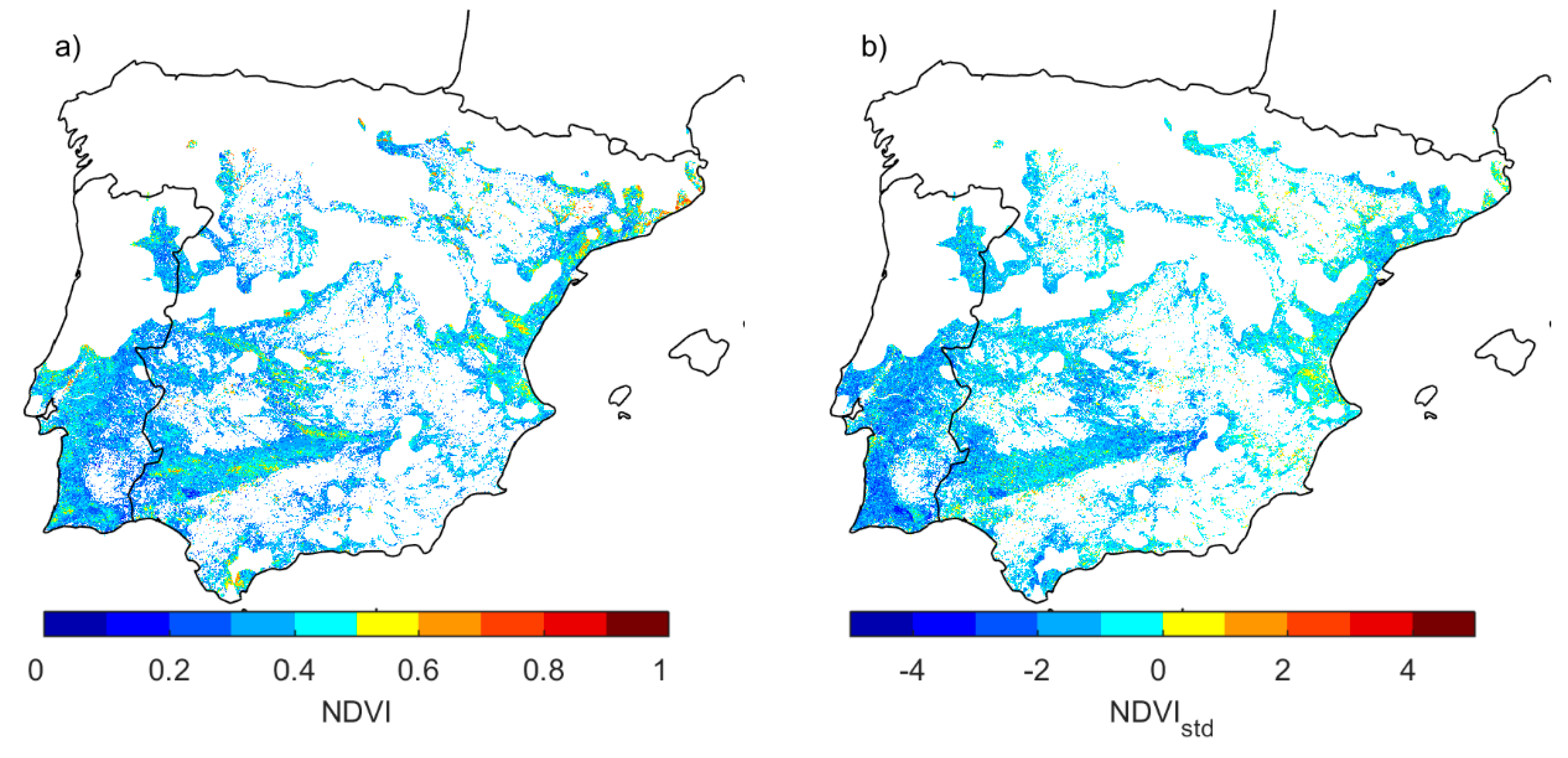
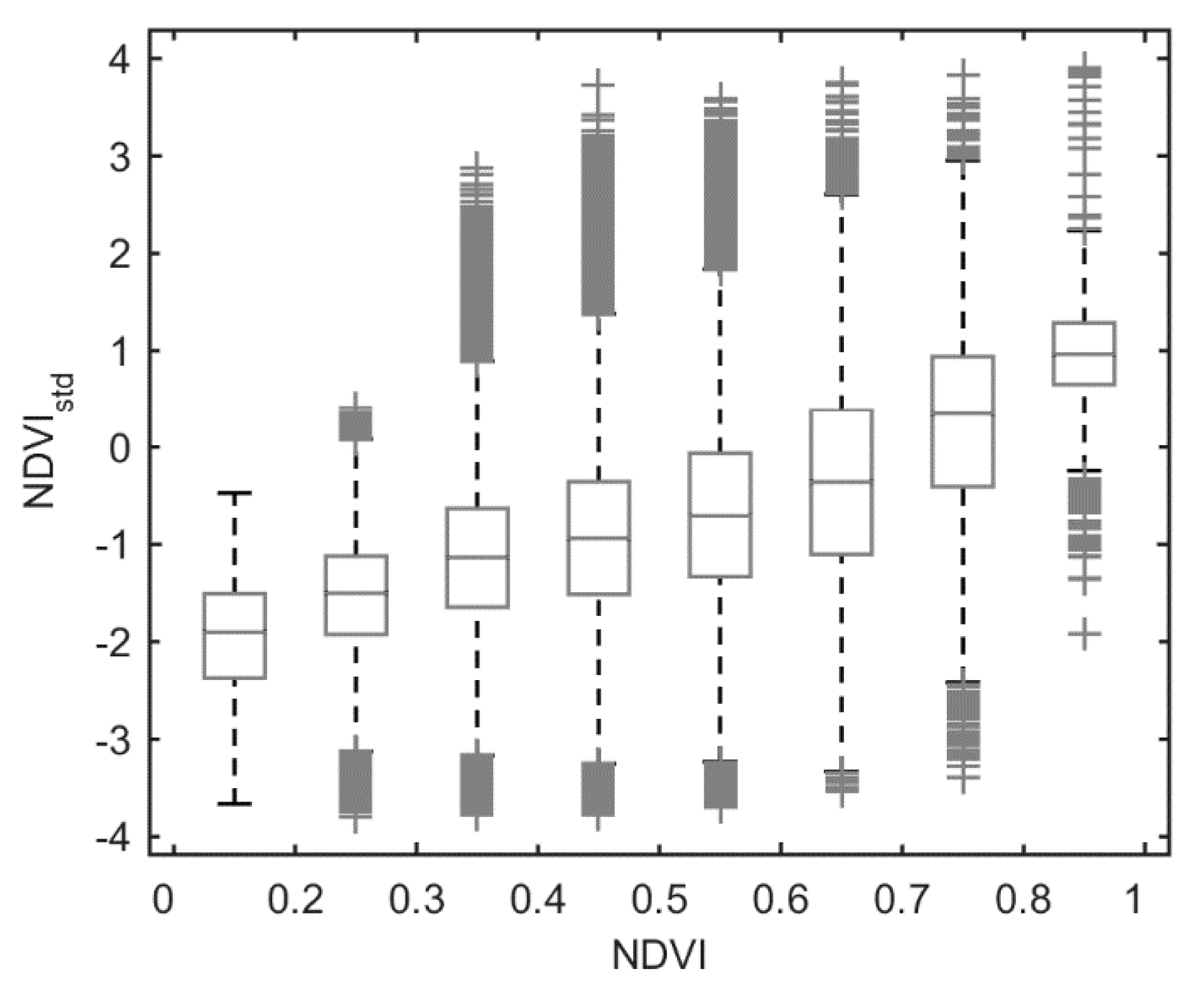
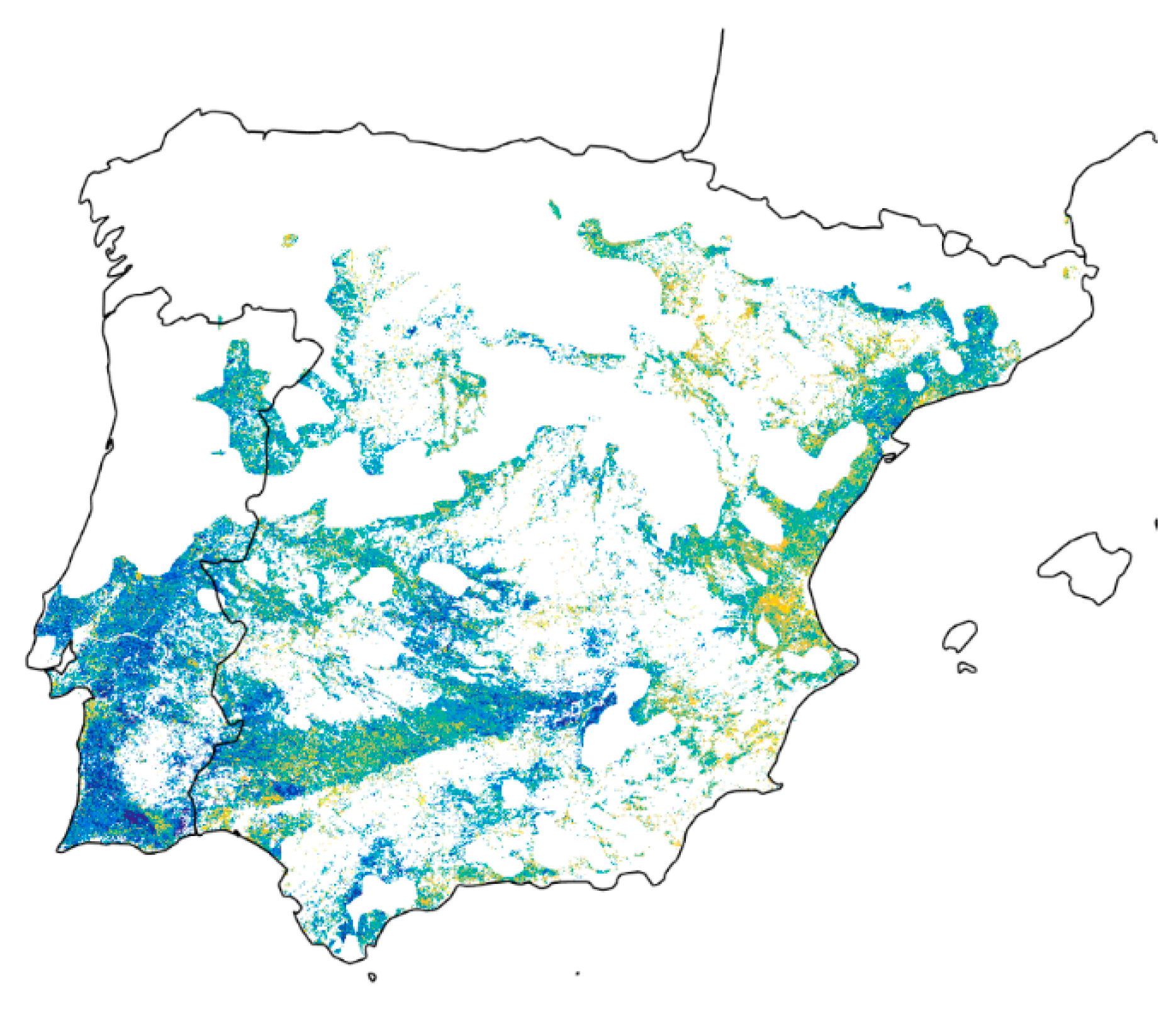
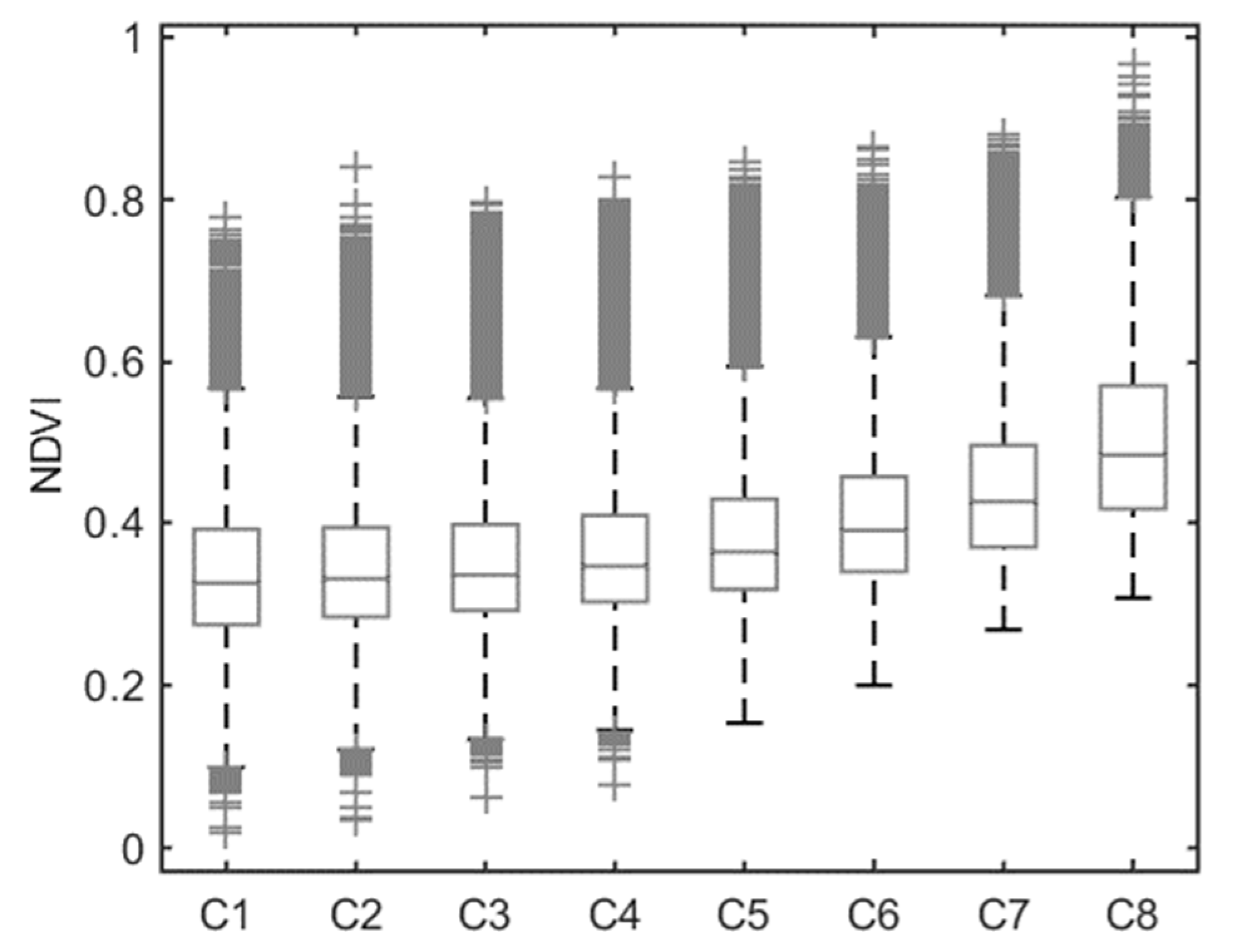
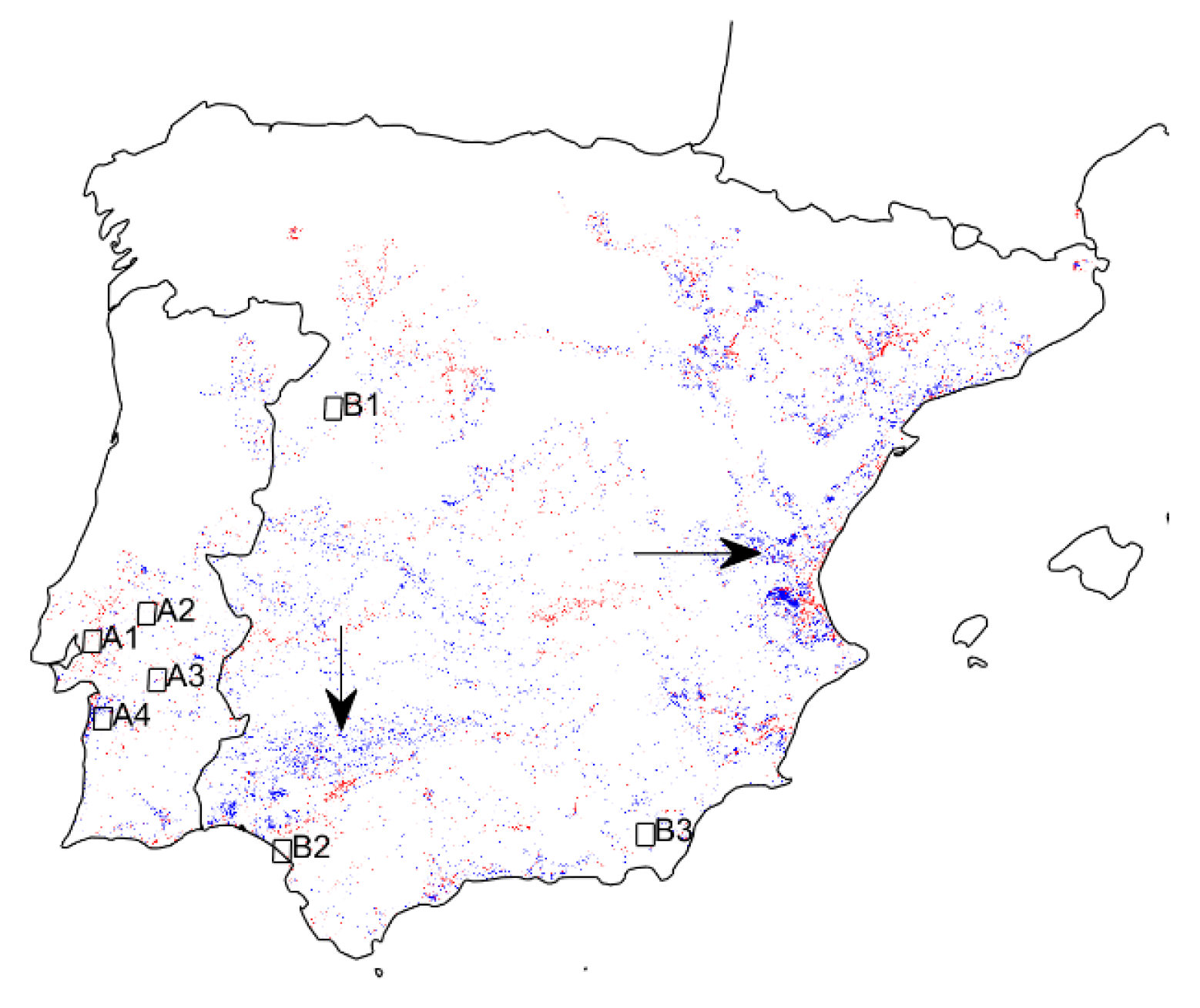
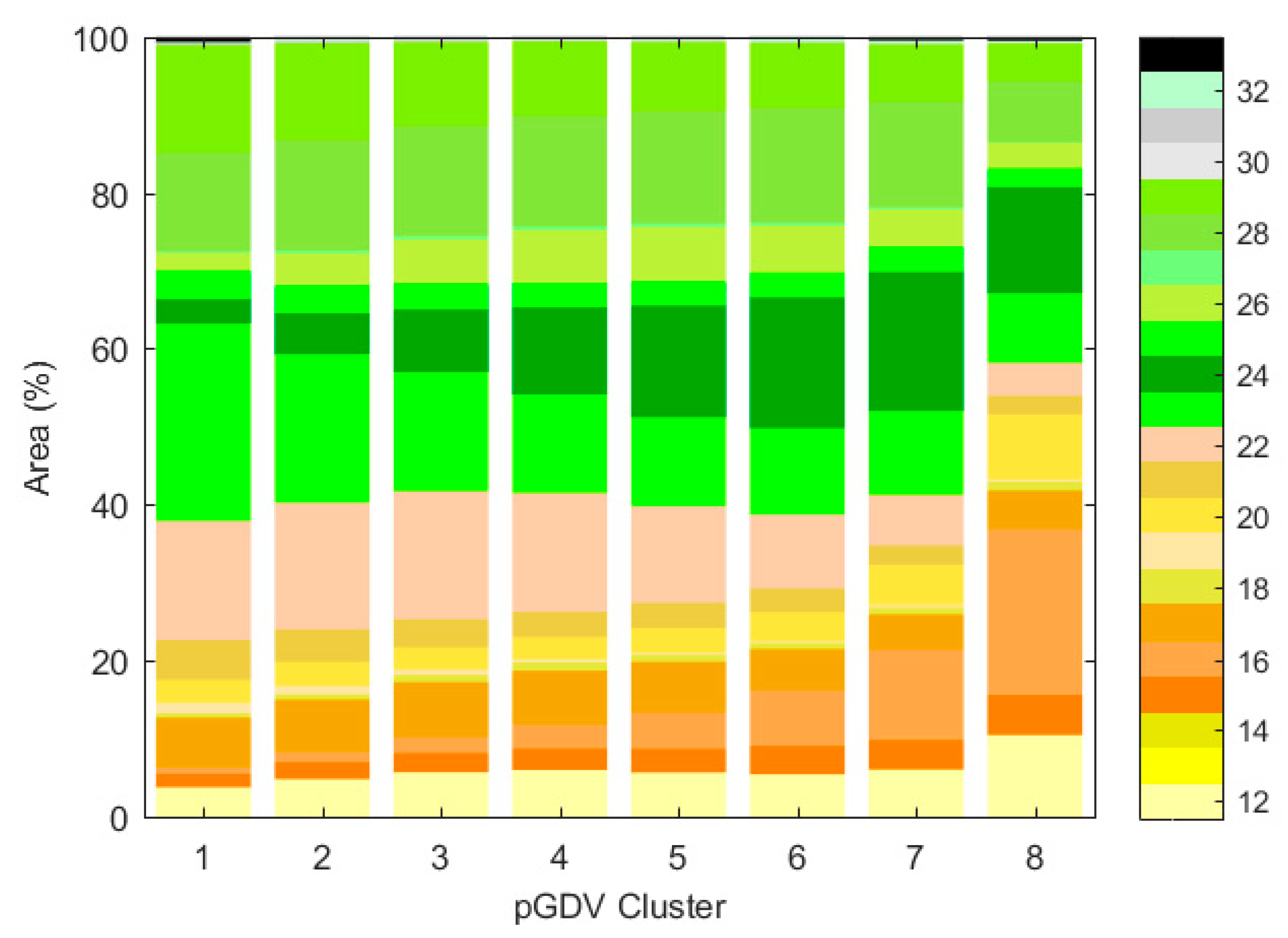
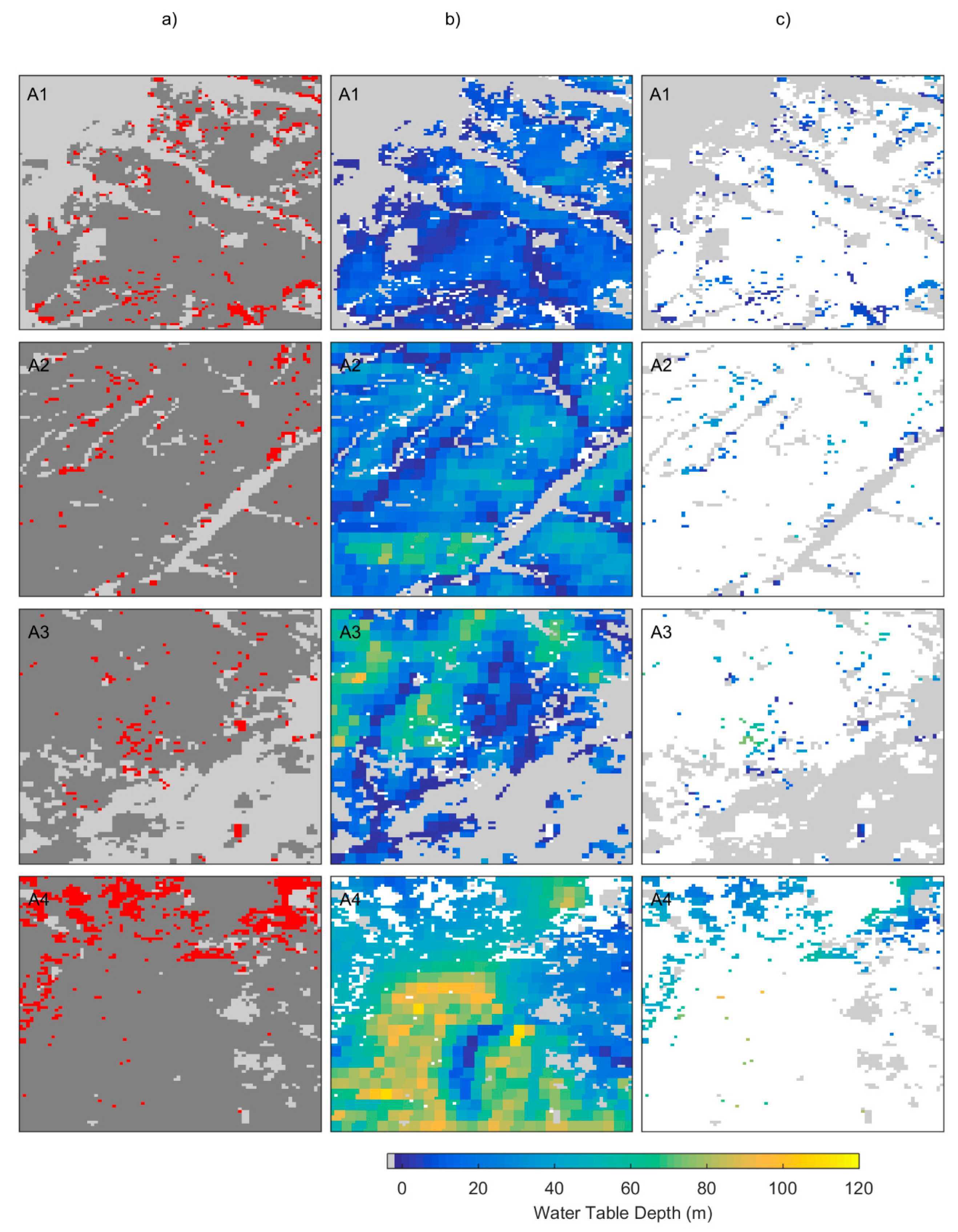
| Land Cover Type | Area (% of the Total) | Area (% of Dry Area) | Area (% of Arid Area) | Area (% of Semi-Arid Area) | Code |
|---|---|---|---|---|---|
| Non-irrigated arable land | 8.18 | 0.09 | 4.79 | 6.78 | 12 |
| Vineyards | 2.76 | 0.27 | 2.87 | 2.87 | 15 |
| Fruit trees and berry plantations | 4.22 | 66.03 | 6.61 | 1.50 | 16 |
| Olive groves | 5.72 | 0.08 | 7.70 | 4.74 | 17 |
| Pastures | 1.06 | 1.46 | 0.82 | 0.95 | 18 |
| Annual crops associated with permanent crops | 0.54 | 0.08 | 0.56 | 0.47 | 19 |
| Complex cultivation patterns | 3.40 | 15.34 | 3.60 | 3.07 | 20 |
| Land principally occupied by agriculture, with significant areas of natural vegetation | 3.38 | 2.71 | 2.74 | 4.14 | 21 |
| Agro-forestry areas | 13.49 | 0.00 | 15.17 | 10.90 | 22 |
| Broad-leaved forests | 13.35 | 0.00 | 13.10 | 15.41 | 23 |
| Coniferous forests | 10.60 | 2.54 | 10.40 | 12.34 | 24 |
| Mixed forests | 3.07 | 0.00 | 2.32 | 4.45 | 25 |
| Natural grasslands | 6.21 | 4.37 | 4.81 | 6.66 | 26 |
| Moors and heathland | 0.43 | 0.00 | 0.19 | 0.70 | 27 |
| Sclerophyllous vegetation | 13.68 | 2.73 | 13.72 | 14.57 | 28 |
| Transitional woodland-shrub | 9.21 | 3.37 | 10.05 | 9.56 | 29 |
| Beaches, dune, sand | 0.03 | 0.00 | 0.04 | 0.02 | 30 |
| Bare rocks | 0.20 | 0.00 | 0.15 | 0.26 | 31 |
| Sparsely vegetated areas | 0.28 | 0.92 | 0.21 | 0.36 | 32 |
| Burnt areas | 0.20 | 0.00 | 0.16 | 0.25 | 33 |
| Glaciers and perpetual snow | 0.00 | 0.00 | 0.00 | 0.00 | 34 |
| Label | Location | Latitude | Longitude | Reference |
|---|---|---|---|---|
| A1 | Herdade das Lezírias, Belmonte | 38°52′55″ | −8°47′49″ | Mendes et al., 2016 [12] |
| A1 | Herdade das Lezírias, Caro Quebrado | 38°50′9″ | −8°49′2″ | Mendes et al., 2016 [12] |
| A2 | Herdade dos Leitões, Montargil | 39°8′00″ | −8°11′00″ | Costa et al., 2016 [13] |
| A3 | Herdade da Mitra | 38°32′0″ | −8°1′ | David et al., 2004 [6] |
| A4 | Herdade de Barradas da Serra, Grândola | 38°11′ | −8°37′ | Costa et al., 2016 [13] |
| B1 | Sardon | 40°59′24″ | −6°6′14″ | Lubczynski et al., 2005 [7] |
| B2 | Biological Reserve of Doñana | 36°59′2″ | −6°29′23″ | Antunes et al., 2018 [14] |
| B3 | Rambla Honda | 37°08′ | 2°22′ | Haase et al. 1996 [4] |
| C1 | C2 | C3 | C4 | C5 | C6 | C7 | C8 | |
|---|---|---|---|---|---|---|---|---|
| Centroid | −2.65 | −2.08 | −1.62 | −1.22 | −0.81 | −0.36 | 0.20 | 1.04 |
| Area (%) | 5.97 | 13.11 | 17.79 | 19.67 | 17.88 | 13.33 | 8.54 | 3.70 |
| C1 | C2 | C3 | C4 | C5 | C6 | C7 | C8 | |
|---|---|---|---|---|---|---|---|---|
| Arid | 0.22 | 1.40 | 3.81 | 8.56 | 14.58 | 23.35 | 27.88 | 20.20 |
| Semi-arid | 6.72 | 13.63 | 17.54 | 19.19 | 18.14 | 13.52 | 8.21 | 3.05 |
| Dry | 5.09 | 12.91 | 19.27 | 21.96 | 19.25 | 13.21 | 6.73 | 1.57 |
| WTD (m) | Study Area (%) | Area (% of Each Cluster) | |||||||
|---|---|---|---|---|---|---|---|---|---|
| C1 | C2 | C3 | C4 | C5 | C6 | C7 | C8 | ||
| WTD < 1.5 | 5.94 | 4.94 -- | 5.11 | 5.13 | 5.27 | 5.52 | 6.36 | 8.99 | 15.79 ++ |
| 1.5 < WTD < 5 | 3.49 | 2.94 -- | 3.02 | 3.11 | 3.14 | 3.20 | 3.72 | 5.06 | 9.22 ++ |
| 5 < WTD < 10 | 4.92 | 4.91 | 4.88 | 4.73 | 4.59 | 4.52-- | 4.90 | 5.93 | 9.36 ++ |
| 10 < WTD < 15 | 5.23 | 5.85 | 5.50 | 5.30 | 5.13 | 4.91 | 4.82-- | 5.24 | 7.06 ++ |
| 15 < WTD < 20 | 5.48 | 6.23 | 5.88 | 5.62 | 5.44 | 5.21 | 5.05-- | 5.14 | 6.25 ++ |
| 20 < WTD < 25 | 5.84 | 6.85 ++ | 6.49 | 6.06 | 5.76 | 5.55 | 5.33-- | 5.37 | 5.45 |
| 25 < WTD < 30 | 6.11 | 6.81 ++ | 6.53 | 6.36 | 6.18 | 5.94 | 5.74 | 5.42 | 5.32 -- |
| 30 < WTD < 40 | 11.92 | 13.33 ++ | 12.66 | 12.33 | 11.86 | 11.74 | 11.48 | 10.79 | 9.27 -- |
| 40 < WTD < 50 | 10.88 | 11.39 ++ | 11.10 | 10.97 | 11.06 | 11.00 | 10.71 | 10.19 | 8.19 -- |
| WTD > 50 | 40.20 | 36.77 | 38.83 | 40.40 | 41.56 | 42.40 ++ | 41.89 | 37.86 | 24.09 -- |
| WTD < 20 | 25.05 | 24.86 | 24.39 | 23.88 | 23.57 | 23.37 | 24.84 | 30.36 | 47.68 |
| WTD > 20 | 74.95 | 75.14 | 75.61 | 76.12 | 76.43 | 76.63 | 75.16 | 69.64 | 52.32 |
| Label | Cluster | Maximum WTD | Minimum WTD | Median WTD |
|---|---|---|---|---|
| A1 | C7-C8 | 34.76 | 0.03 | 6.71 |
| C1-C6 | 37.06 | 9.89 | ||
| A2 | C7-C8 | 58.97 | 0.08 | 21.84 |
| C1-C6 | 80.99 | 25.09 | ||
| A3 | C7-C8 | 74.69 | 0.16 | 20.98 |
| C1-C6 | 96.69 | 21.53 | ||
| A4 | C7-C8 | 97.26 | 5.75 | 37.19 |
| C1-C6 | 110.68 | 53.26 |
© 2020 by the authors. Licensee MDPI, Basel, Switzerland. This article is an open access article distributed under the terms and conditions of the Creative Commons Attribution (CC BY) license (http://creativecommons.org/licenses/by/4.0/).
Share and Cite
Páscoa, P.; Gouveia, C.M.; Kurz-Besson, C. A Simple Method to Identify Potential Groundwater-Dependent Vegetation Using NDVI MODIS. Forests 2020, 11, 147. https://doi.org/10.3390/f11020147
Páscoa P, Gouveia CM, Kurz-Besson C. A Simple Method to Identify Potential Groundwater-Dependent Vegetation Using NDVI MODIS. Forests. 2020; 11(2):147. https://doi.org/10.3390/f11020147
Chicago/Turabian StylePáscoa, Patrícia, Célia M. Gouveia, and Cathy Kurz-Besson. 2020. "A Simple Method to Identify Potential Groundwater-Dependent Vegetation Using NDVI MODIS" Forests 11, no. 2: 147. https://doi.org/10.3390/f11020147
APA StylePáscoa, P., Gouveia, C. M., & Kurz-Besson, C. (2020). A Simple Method to Identify Potential Groundwater-Dependent Vegetation Using NDVI MODIS. Forests, 11(2), 147. https://doi.org/10.3390/f11020147






